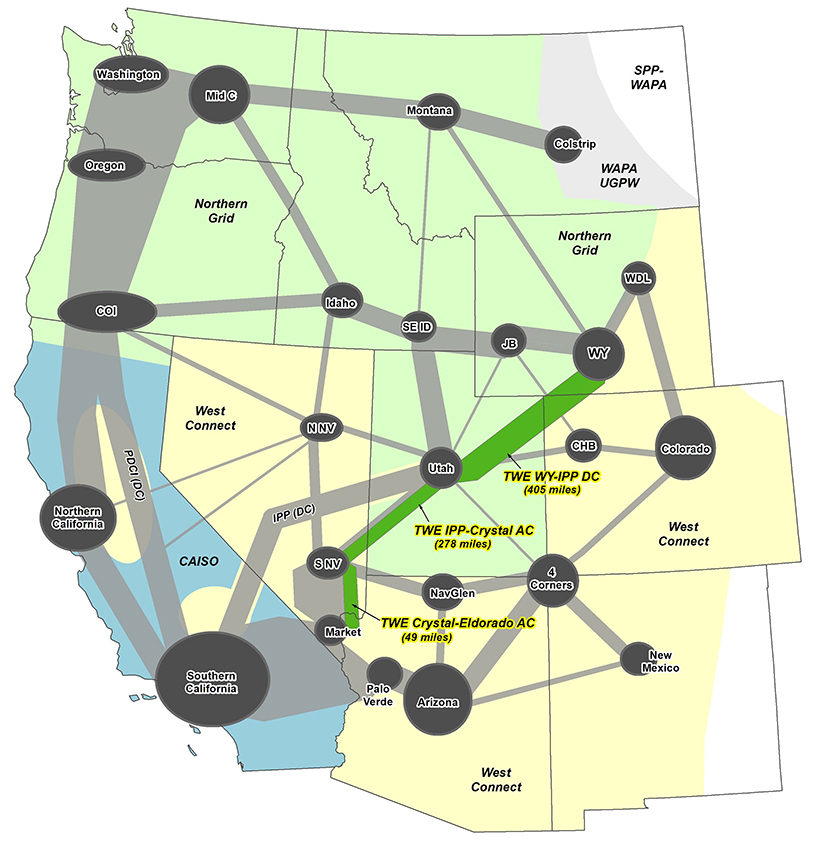Designing transmission with a long-term vision
Federal, regional and state entities have long recognized both the need and the benefits of investing in new regional and inter-regional transmission systems – and of designing those systems "smart from the start." These entities have encouraged the development of transmission systems through adoption of various laws, policies and planning initiatives.
Since its inception in 2005, the TWE Project has been carefully planned in alignment and collaboration with leading transmission/electrical infrastructure planning groups. This work assures that the multibillion-dollar TWE Project:
- Connects cost-effective energy resources to the grid.
- Coordinates with other projects and with sub-regional planning groups.
- Adds system reliability, stability and capacity for the Western Interconnection, which is the power grid that connects all of the western states.
The TWE Project represents the type of regional transmission envisioned in multiple federal and regional policies and studies to connect the West's generation resources.

A pipe diagram of the Western Interconnection shows that the bulk of the existing transmission capacity, shown in gray, is built along the coast in a "C." It also shows there is limited capacity between the California/Desert Southwest and Intermountain regions. Limited capacity means there is limited access to both diverse renewable resources and to diverse load areas. However, adding the 3,000 MW DC line system and 1,500 MW AC line system of the TWE Project vastly expands the ability to directly and efficiently exchange resources between regions.
Cost-effectiveness
The Western Electricity Coordinating Council (WECC) is the primary entity responsible for coordinating and promoting bulk electric system reliability in the Western Interconnection. In 2010, WECC initiated a Regional Transmission Expansion Planning process that was funded in part by the U.S. Department of Energy. The first report was WECC's 10-Year Regional Transmission Plan, issued in 2011.
The 10-Year Plan showed that, with Wyoming's exceptionally high-quality wind, the TWE Project will provide the most cost-effective remote renewable energy resource alternative in the Western Interconnection.
The 10-Year Plan's economic results were consistent with previous studies by Western Electric Industry Leaders and National Grid that underscored the economic benefits of tapping Wyoming's high-capacity wind energy.
In 2014, the economic benefits of investing in new direct current transmission between California and Wyoming were confirmed in a study conducted by the DOE's National Renewable Energy Lab. The study found that the economic benefit of such a transmission line is likely to outweigh the costs, with benefit-to-cost ratios ranging from 1.6 to 3.6. Utilities typically consider a new transmission line project as a worthwhile economic investment if the benefit-to-cost ratio is 1.1 to 1.2.
Planning coordination
In addition to WECC, there are sub-regional planning groups that exist throughout the western U.S. As an interstate transmission system proposed to cross Wyoming, Colorado, Utah and Nevada, the TWE Project will interconnect multiple sub-regions. Therefore, in alignment with the importance of coordinating with these groups, TransWest has participated within the planning efforts of these sub-regions for several years as well.
System reliability
The TWE Project will be one of the largest transmission elements within the WECC system. It will up to quadruple the transmission capacity that currently exists between the California ISO and the PacifiCorp balancing areas.
The WECC Rating Process is designed to ensure that transmission projects are properly integrated into the existing transmission grid to enhance the overall reliability of the grid. This process for the TWE Project as a DC-only configuration was initiated in 2008, and this process for the TWE Project with a DC and AC configuration was initiated in 2018. TransWest is a WECC member.
The TWE Project has been the subject of a Regional Planning Project Review conducted in accordance with Western Electricity Coordinating Council planning procedures. Initiated in mid-2007, the review was conducted jointly with PacifiCorp's Energy Gateway South Transmission Project, a proposed 500kV alternating-current transmission line.
- A Conceptual Technical Report performed as part of the Regional Planning Project Review determined that both transmission projects will cost-effectively serve the Desert Southwest region while minimizing environmental impact.
- The Regional Planning Project Review also included extensive stakeholder consultation to ensure the efficient development of an overall regional transmission plan. Four public meetings were held in 2007 and 2008 in Wyoming, Utah, Nevada and Arizona.
In addition, the TWE Project was included in work performed by:
- The Northern Tier Transmission Group, which coordinates planning in the Northwest and Mountain states, included the TWE Project within the study work performed as part of its Fast Track Project Process and 2007 Annual Planning Report.
- WestConnect, which coordinates planning in Nevada, Arizona, New Mexico and Colorado, included the TWE Project in its 2008-2017 Transmission Plan.
Reports
- FERC Staff Report to Congress, "Report on Barriers and Opportunities for High Voltage Transmission," June 2020.
- NREL’s California-Wyoming Grid Integration Study: Phase 1 – Economic Analysis, March 2014
- WECC 10-Year Regional Transmission Plan, Sept. 22, 2011
- AWEA/SEIA Green Power Superhighways report, February 2009
- The West’s Renewable Energy Future: A Contribution by National Grid, July 2008
- TransWest Express Transmission Project Regional Planning Project Review Report, May 30, 2008
- NTTG 2007 Annual Planning Report, April 2, 2008
- Gateway South and TransWest Express Conceptual Technical Report, Feb. 29, 2008
Stay informed
![]() Join TransWest's email list to receive periodic updates and meeting notifications.
Join TransWest's email list to receive periodic updates and meeting notifications.
 Follow us on X/Twitter.
Follow us on X/Twitter.
In the news
"Our Nation’s electric transmission grid is the backbone of our economy, a key factor in future economic growth, and a critical component of our energy security. … Modernizing our grid will improve energy reliability and resiliency."
- Presidential Memorandum, June 7, 2013